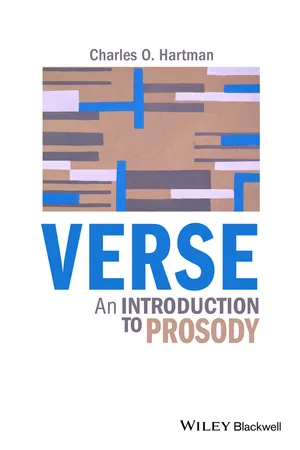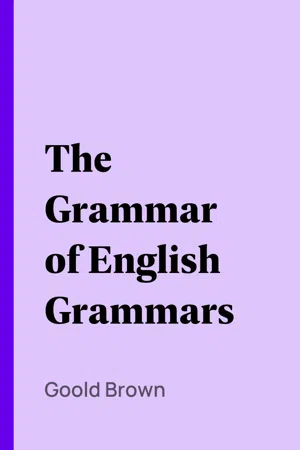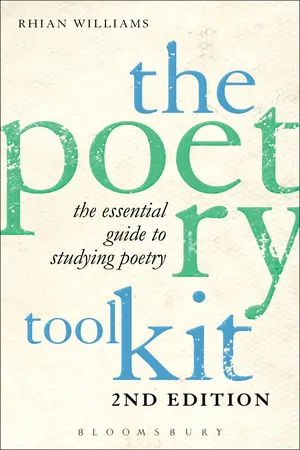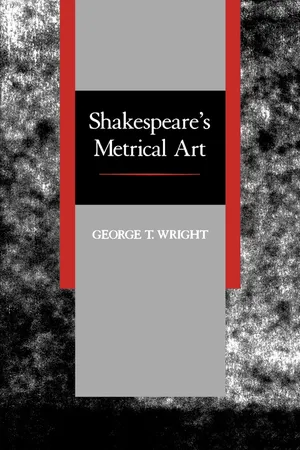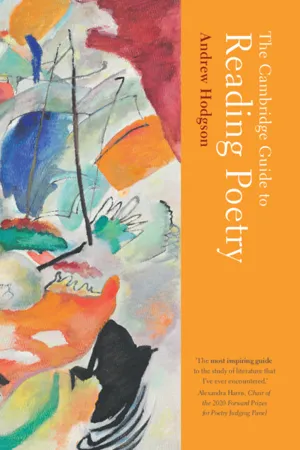Literature
Anapest
An anapest is a metrical foot in poetry consisting of two short or unstressed syllables followed by a long or stressed syllable. It is a rhythmic pattern commonly used in poetry and is often associated with a flowing and upbeat feel. Anapestic meter is frequently used in lighthearted or humorous poetry due to its lively and bouncy rhythm.
Written by Perlego with AI-assistance
8 Key excerpts on "Anapest"
- eBook - ePub
Verse
An Introduction to Prosody
- Charles O. Hartman(Author)
- 2015(Publication Date)
- Wiley-Blackwell(Publisher)
Anapests, with just one stress in three syllables, go the other way, toward relaxation. Furthermore, a series of Anapests in a row produce a “runaway horse” effect – sentences galloping recklessly over whatever they try to communicate – that tends to drown out any subtler music. Poets are wary of these “triple threats to duple rhythm,” as the critic Edward Weismiller has called them. (A duple rhythm is one based on a two-syllable foot like the iamb.) If a line has a string of especially light stresses – “I do not at this point in time agree” – it can be all too easy to hear and scan as an Anapestic tetrameter: x x / | x x / | x / | x / (?) I do not at this point in time agree (This is a made-up bad example; poets avoid this kind of uncertainty in meter.) The solution, when scanning a line, is to remember to hold the number of feet in the line constant. The Persistence of Line Length If the poem begins in iambic pentameter, expect every line to have five feet. (Remember that the double iamb counts as two.) What the five feet are can vary, but not their number. It’s useful to think of this rule as absolute: when you’re scanning a poem in iambic pentameter, always check to make sure every line has five feet, not four or six. These are easy mistakes to make. You’ll encounter two kinds of exceptions to this rule. First, when lines are collected into stanza forms (which we’ll discuss in Chapter 3), those repeated stanzas may systematically vary the number of feet in particular lines. The Spenserian stanza, for example, is eight iambic pentameters followed by one iambic hexameter. Keats’s “Ode to a Nightingale” is mostly in iambic pentameter, but he shortens the eighth line of each stanza to an iambic trimeter. Second, in the period when iambic pentameter dominated English poetry most thoroughly – roughly, the “long Eighteenth Century” – an accepted source of variety was to introduce an occasional hexameter - eBook - ePub
Meter in English
A Critical Engagement
- David Baker(Author)
- 1997(Publication Date)
- University of Arkansas Press(Publisher)
This view, while it invites interesting statistical studies, obscures important patterns in the overall structures of poems. Iambic poems tend to resolve passages of rhythmic complication in strongly iambic lines, Anapestic poems resolve on Anapestic lines, and trochaic poems on trochaic lines. Whether we can identify these points of resolution or release of metrical tension in a poem partly determines whether we can grasp its movement as a whole—which is surely the ultimate goal of metrical and rhythmic analysis and training. One final demonstration of the fundamental difference between iambic and Anapestic poems may convince some scholars more than others: It is possible to write a computer program that accurately scans iambic poems, even those of such metrical complexity as “The Second Coming.” That program (which I have implemented in several forms) breaks down completely when confronted with a poem like “Ah Sun-flower.” Of course one can add more to the program to handle these cases; but in doing so one is specifically accommodating the habits of Anapestic verse. (The program must choose, on a crude but adequate statistical basis, whether to treat a given input as Anapestic or iambic before it knows how to begin processing individual lines.) The distinction is, in this sense, procedural and deterministic, not a matter of degree or style or taste in metrical systems. If I am right that we must acknowledge the existence of Anapestically-based poems, then we must also recognize that such poems tend to invite different kinds of foot substitution from iambic ones. Wallace announces that the cretic (or amphimacer—we can postpone the secondary question of what to call these things) does not exist in English (“or, to put it differently . . . [it] might be rationalized in a different or simpler way”) - eBook - ePub
- Goold Brown(Author)
- 2004(Publication Date)
- Perlego(Publisher)
Anapestic Monometer," or "the line of one Anapest," while others—(as Allen, Bullions, Churchill, and Hiley—) will have the length of two Anapests to be the shortest measure of this order. Prof. Hart says, "The shortest anapæstic verse is a single anapæst; as,'~In =a sw=eet R~es~on=ance, ~All th~eir f=eet ~In th=e d=ance ~All th=e n=ight T~inkl~ed l=ight.'This measure," it is added, "is, however, ambiguous; for by laying an accent on the first, as well as the third syllable, we may generally make it a trochaic."—Hart's English Gram., p. 188. The same six versicles are used as an example by Prof. Fowler, who, without admitting any ambiguity in the measure, introduces them, rather solecistically, thus: "Each of the following lines consist of a single Anapest."—Fowler's E. Gram., 8vo, 1850, §694.OBS. 3.—Verses of three syllables, with the second short, the last long, and the first common, or variable, are, it would seem, doubly doubtful in scansion; for, while the first syllable, if made short, gives us an Anapest, to make it long, gives either an amphimac or what is virtually two trochees. For reasons of choice in the latter case, see Observation 1st on Trochaic Dimeter. For the fixing of variable quantities, since the case admits no other rule, regard should be had to the analogy of the verse, and also to the common principles of accentuation. It is doubtless possible to read the six short lines above, into the measure of so many Anapests; but, since the two monosyllables "In" and "All" are as easily made long as short, whoever considers the common pronunciation of the longer words, "Resonance" and "Tinkled," may well doubt whether the learned professors have, in this instance, hit upon the right mode of scansion. The example may quite as well be regarded either as Trochaic Dimeter, cataletic, or as Amphimacric Monometer, acatalectic. But the word resonance, being accented usually on the first syllable only, is naturally a dactyl; and, since the other five little verses end severally with a monosyllable, which can be varied in quantity, it is possible to read them all as being dactylics; and so the whole may be regarded as trebly doubtful - eBook - PDF
- Rhian Williams(Author)
- 2013(Publication Date)
- Bloomsbury Academic(Publisher)
When they are used more playfully or colloquially, as in some of Browning’s poems, the dactyl falls in more with other triple-syllabled feet, such as anapaests, which, as we’ve seen, at one time were regarded as ‘unpoetic’, disruptive, unruly feet that distracted from the serious mode of contemplation that some readers wished to preserve for poetry. Thus we see that feet have culture to bring to a poem as well as a rhythm; Annie Finch’s study considers this notion in more detail, and her introduction includes a useful summary of the cultural associations ascribed to metrical feet. References Finch, Annie, The Ghost of Meter: Culture and Prosody in American Free Verse (Michigan: University of Michigan Press, 1993). Hopkins, Gerard Manley, Journals and Papers , ed. Humphry House (Oxford: Oxford University Press, 1959), pp. 274–5. —‘Author’s Preface’, in Catherine Phillips ed., Gerard Manley Hopkins: The Major Works (Oxford: Oxford University Press, 2002), pp. 106–9. Meynell, Alice, The Flower of the Mind (London: Grant Richards, 1893). 3.4 Metrical lines Stich A line of poetry. Having seen how lines of verse fall into feet, we come to naming these lines metrically; that is, after their metre. The term ‘stich’ is used fairly infrequently, in fact; a line of poetry tends to be characterized first by the type of feet it includes and secondly by the number of feet. If the number of feet varies in each line of the poem then the metre is named simply after the type. This chilling example by Southey mainly uses iambic feet, but the line lengths vary: Prosody 159 [Old Sa -] [rah loved ] [her help -] [less child ] [Whom help -] [less-ness ] [made dear ;] And life was happ i ness to him Who had no hope nor fear . Robert Southey, ‘The Idiot’ (1798), ll. 5–8. Here the number of feet shifts between four and three per line and so the poem may be described as showing alternating iambic tetrameter (four feet) and trimeter (three feet). - eBook - PDF
- George T. Wright(Author)
- 1988(Publication Date)
- University of California Press(Publisher)
1 I Shakespeare's Metrical Art Patterns we find in poetry always derive from patterns we discern or intuit in the world around us. 2 The arrangement of words and phrases in poetic lines reflects our custom of speaking, and of hearing each other speak, in a succession of rhythmic units; if the lines are metrical, if they make patterns out of series of lightly or strongly stressed syllables, they reflect the fact that when we speak we speak a succession of syllables with greater and lesser degrees of stress. If verse is iambic, that means that it assumes as a fundamental feature of our speech the frequent—and some-times regular and rhythmic—alternation of unstressed and stressed syl-lables, and that it mirrors our occasional tendency to use several of those two kinds of syllables in that order—a climactic order perhaps, a rising rhythm (as it is often called), in which the movement is repeatedly (and even noticeably) from the less prominent syllable to the more prominent. Within the line we will usually be more aware of a quick succession of syllables with contrasting degrees of stress than of an insistent series of iambs; it is easier to notice the alternation than to say whether at any point the rhythm is iambic or trochaic. The first foot in iambic verse, too, is frequently reversed, so that we start the line with a stressed syllable. The last foot, however, is rarely reversed, and the pattern we come to know as we keep listening to iambic meter is one that moves inexorably, through several different modes of passage, to a final confirmation of iambicity. On the other hand, poems that use many feminine endings tend to undermine this feature of iambic verse and may have some expressive reason for do-ing so. - Mick Short(Author)
- 2018(Publication Date)
- Routledge(Publisher)
138 Exploring the language of poems, plays and prose when iambic pentameter was new as a form, poets did not relax the metrical form much because they needed to establish the pattern. However, after the pattern became established, poets could more easily deviate from the basic metrical structure, thus producing a wider and more interesting range of tension effects. 5.5.2 Metrics and the English stress system Besides the tensions created by the act of getting the right number of syllables into a line, there is also possible tension between the metrical system and the language system in terms of what we might call strong and weak events. Let us pretend that in a slot where the metrical pattern predicts a remiss (weak event) followed by an ictus (strong event), we want to have the word 'summer'. Where the metre predicts a weak event the language rules predict a strong event, and vice-versa. As we noted in 5.1, every lexically full word in English has an accented syllable, the syllable which normally takes a strong stress in speech. The same is true of the grammatical words which consist of more than one syllable, like 'upon' and 'below'. If we make the metre overrule the normal stress- assignment dictates for English, we get a highly unnatural, 'metrical' reading, of the sort young children produce when they are beginning to learn to read poetry out loud. If the normal stress-assignment rules are given precedence over the metre, in this case we have what is traditionally known as a reversed foot and a correspondingly less metrical reading. A good example of a reversed foot in an iambic pentameter poem would be the first word of 'Trances of thought and mountings of the mind' (line 20 of the first book of Wordsworth's Prelude, my emphasis). A competent reader would need a fairly extraordinary set of contextual communicative circumstances to reverse the strong and weak stresses normally associated with the accented and unaccented syllables respectively of Trances.- eBook - PDF
- Andrew Hodgson(Author)
- 2021(Publication Date)
- Cambridge University Press(Publisher)
In practice, such occurrences are rare: it is seldom that one syllable in a foot doesn’t take slightly more emphasis than another, even if both seem very heavily or lightly stressed. Spondaic and pyrrhic feet never form the basis of any metrical poem in English – they are best reserved for describing interrup- tions to a prevailing metrical pattern and are perhaps most usefully thought of as positions to which iambic or trochaic feet might tend when the difference in emphasis between the syllables in a foot is very slight, and not phenomena which commonly occur in their ideal form. Even in the abstract, we can begin to see how different metrical patterns open up different possibilities of expression. Tap out a sequence of trochees – DUM-der | DUM-der | DUM-der . . . – and a sequence of anapaests – der-der-DUM | der-der-DUM | der-der-DUM .. . – and you will hear the rhythms wreathing themselves around the beats with differing pace and texture. To calculate the length of a line, we count the number of metrical feet – and consequently the number of beats – it contains. The names for describing these lengths are derived from Greek, and are as follows: monometer – one foot dimeter – two feet trimeter – three feet tetrameter – four feet pentameter – five feet hexameter – six feet (sometimes known as an alexandrine) 78 Reading a Poem heptameter – seven feet octometer – eight feet Differing lengths of line, as we have seen, open up different possibilities of movement and expression. Shorter lines tend to give a rapid, staccato feel, leaving little space within the line to expand beyond a single phrase or image and little scope to vary the metrical pattern; four-foot lines tend to create an emphatic regular beat – you find them often in popular song and ballad forms – and they are well suited to witty poems, like the example from Prior above; five-foot lines dampen that beat, and allow more flexibility and variety of modulation. - eBook - PDF
- Christiana Gregoriou(Author)
- 2017(Publication Date)
- Red Globe Press(Publisher)
❚ 1.2 Rhythm and metre ‘Rhythm’ is something we perceive in many things, such as the beating of our hearts, the sound of a machine, or indeed music. It is essentially a pattern of stresses, the perception human beings have of ‘on’ and ‘off’ beats, strong and weak ones, correspondingly referred to as the ‘ictus’ (/) and the ‘remiss’ (X). In the context of the English language, this rhythm is evident in the amount of time that elapses between the stressed syllables of words. Poetry, as a special linguistic form, ‘has more marked, and more complex, rhythmic effects than ordinary language because it has an extra layer of rhythmic structuring which is usually called metre ’ (Short, 1996: 127). Metre is a pattern of rhythm which is perceived to be deliberately regular. Metrical feet in poetry are defined on the basis of this regular pattern, and carry only one strong syllable each. A set of Greek-derived terms have traditionally been used to classify patterns of rhythm into metres that are ‘iambic’ (that is ‘X /’, such as the stress in ‘before’), ‘trochaic’ (that is ‘/ X’, such as in ‘butter’), ‘anapaestic’ (that is ‘X X /’, such as in ‘reconstruct’) and ‘dactylic’ (that is ‘/ X X’, such as in ‘passenger’). Depending on the number of metrical feet that a poem’s lines have, we use the again Greek-derived terms ‘monometer’ (one-metre line), ‘dimeter’ (two-metre line), ‘trimeter’ (three-metre line), ‘tetrameter’ (four-metre line), ‘pentameter’ (five-metre line) and ‘hexameter’ (six-metre line). Let us look at some examples of the various forms. According to Short (1996: 132), the metrical norm for English poetry, from the fifteenth century onwards, is the iambic pentameter. Michael Drayton’s ‘Since there’s no help, come let us kiss and part’ ([1619]; in Woudhuysen, 1993) follows this decasyllabic (ten-syllable) metre.
Index pages curate the most relevant extracts from our library of academic textbooks. They’ve been created using an in-house natural language model (NLM), each adding context and meaning to key research topics.
